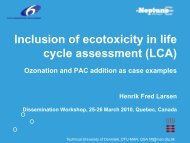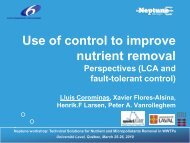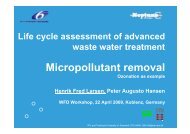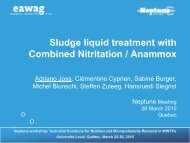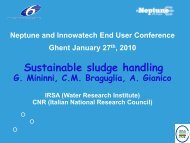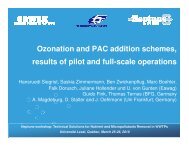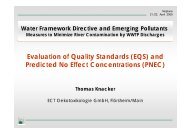D2.1 - EU Project Neptune
D2.1 - EU Project Neptune
D2.1 - EU Project Neptune
You also want an ePaper? Increase the reach of your titles
YUMPU automatically turns print PDFs into web optimized ePapers that Google loves.
NEPTUNE · Contract-No. 036845 Deliverable 2.1<br />
2.2.2 Description of work undertaken<br />
The main focus of the work was to investigate the potential of using VFA mixtures, as<br />
present in fermented sludge hydrolysate, for current generation using microbial fuel cells.<br />
The proposed process diagram is show in (Figure 2.2). The work has comprised of two parts:<br />
Part One: analysis of MFC performance with synthetic influent (single and mixed VFA),<br />
evaluating the impact of loading and anode potential on both performance (i.e. current<br />
generation) and VFA removal;<br />
Part Two: analysis of MFC performance with fermented sludge hydrolysate.<br />
The work thus far has been undertaken with a granular-type frame reactor with potassium<br />
ferricyanide as the catholyte.<br />
Figure 2.2 Flow diagram of concept<br />
2.2.3 Results<br />
The work thus far with pure VFA influent streams has demonstrated that the main<br />
constituents of fermented sludge hydrolysate can effectively be degraded using a MFC<br />
(loading of 1.9 gCOD/L.d, 500 mg/L COD). However, large differences exist between the<br />
VFAs, with acetate and propionate more readily used. This highlights the possible role of a<br />
fermenter operating in tandem, producing an MFC influent with a higher concentration of the<br />
VFAs that are more readily degradable. Further work with potentiostatic control of the MFC<br />
reactors (i.e. no longer limited by constant resistance between the positive and negative<br />
poles of the cell) will help identify the operational parameters necessary to achieve a high<br />
Coulombic efficiency with the whole VFA spectrum.<br />
Initial work with mixed synthetic influent streams, representing the typical output of a<br />
fermenter operating with CAMBI effluent, have demonstrated the ability of the MFC<br />
technology to produce a steady current over a reasonable time period (two weeks), with the<br />
removal of VFAs [over 50% reduction of COD (mgCOD/L)] and achieving Coulombic<br />
6



